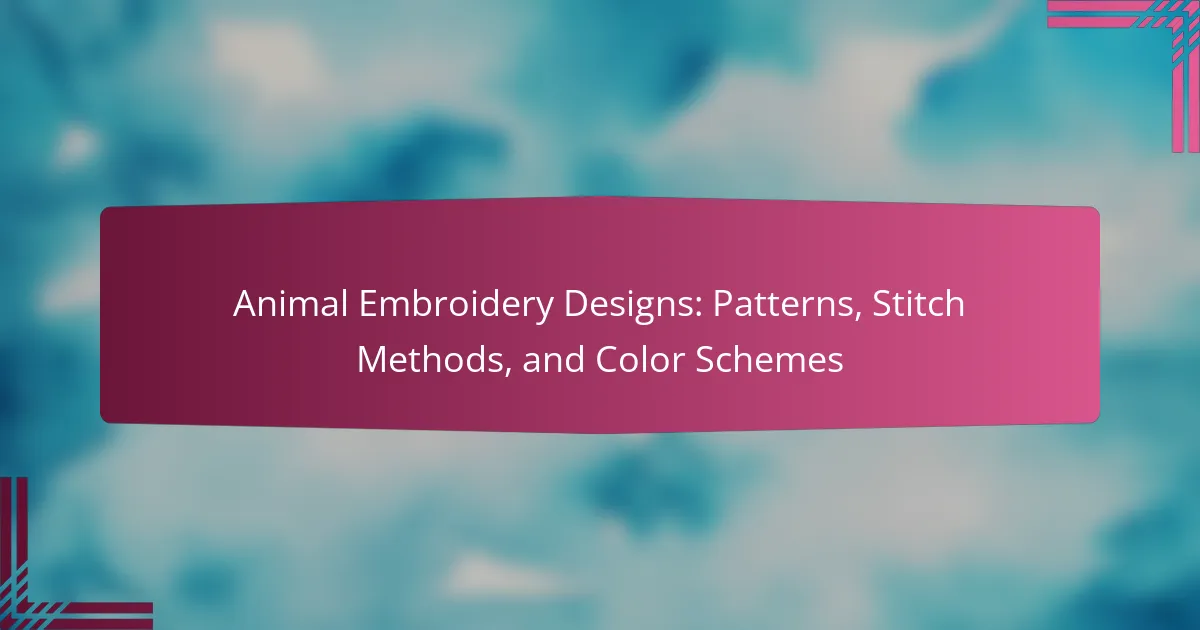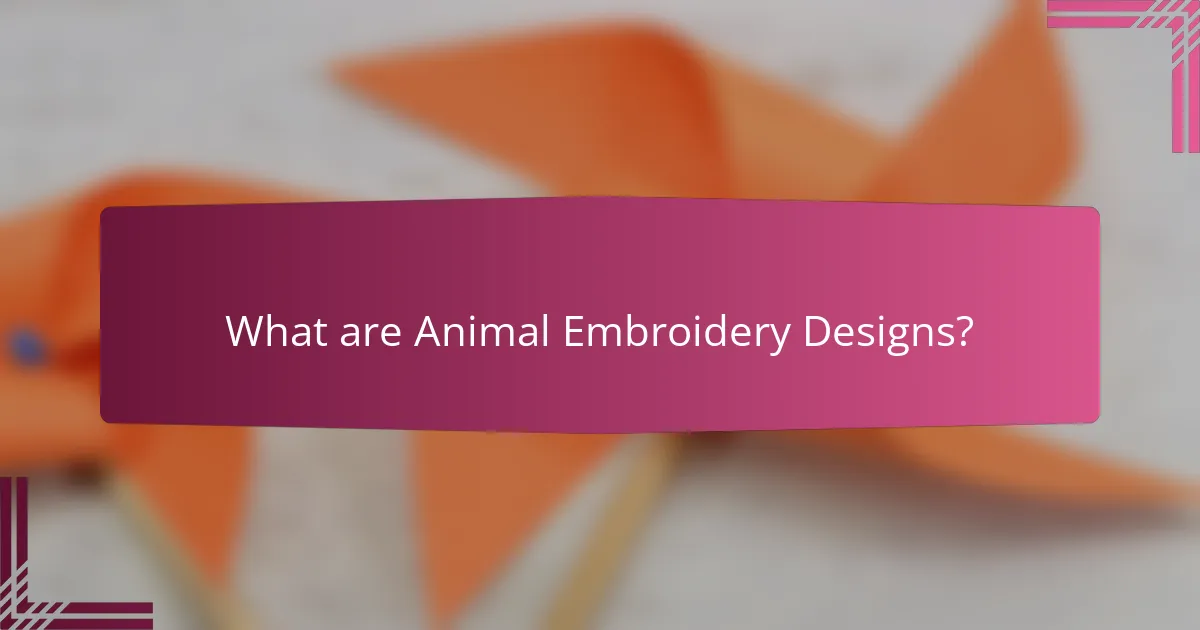
What are Animal Embroidery Designs?
Animal embroidery designs are decorative patterns that feature animals as their primary subject. These designs can be created using various stitching techniques. Common methods include satin stitch, backstitch, and cross-stitch. Animal embroidery often incorporates vibrant colors to enhance visual appeal. The designs can be used on clothing, home decor, and accessories. Historical records show that animal motifs have been popular in textiles for centuries. This popularity is evident in cultures worldwide, from ancient tapestries to modern fashion.
How do Animal Embroidery Designs differ from other embroidery styles?
Animal embroidery designs focus specifically on depicting animals, which sets them apart from other styles. They often utilize realistic representations and intricate details to capture the essence of the animal. This style typically employs vibrant colors to enhance the visual appeal of the animal motifs. In contrast, other embroidery styles may focus on abstract patterns or floral designs. The stitching methods used in animal embroidery can also be more complex, requiring specialized techniques to achieve lifelike textures. For instance, shading and contouring are often used to create depth in animal features. Overall, the unique focus on animal forms and the detailed craftsmanship distinguish animal embroidery from other embroidery styles.
What are the key characteristics of Animal Embroidery Designs?
Animal embroidery designs are characterized by their intricate patterns and vibrant colors. They often depict various animals, showcasing realistic or stylized representations. Common stitch methods include satin stitch, backstitch, and French knots, which enhance detail and texture. Color schemes typically feature a diverse palette to capture the essence of the animals. Additionally, these designs can vary in size and complexity, catering to different skill levels. Animal embroidery often incorporates unique attributes, such as cultural significance or symbolic meanings associated with specific animals. These characteristics contribute to the popularity and artistic value of animal embroidery in textile art.
Why are Animal Embroidery Designs popular among crafters?
Animal embroidery designs are popular among crafters due to their aesthetic appeal and versatility. These designs can be easily adapted to various projects, from home decor to clothing. Crafters appreciate the ability to personalize their creations with unique animal motifs. Additionally, animal designs often evoke emotional connections, making them meaningful to the creator. The variety of styles, from realistic to whimsical, caters to different tastes and skill levels. Furthermore, the use of vibrant colors in animal embroidery enhances visual interest. Many crafters find joy in the challenge of mastering different stitch methods associated with these designs. Overall, the combination of creativity, personalization, and emotional resonance drives the popularity of animal embroidery among crafters.
What types of animals are commonly featured in embroidery designs?
Common animals featured in embroidery designs include birds, butterflies, and cats. Birds are popular due to their vibrant colors and symbolic meanings. Butterflies are often chosen for their delicate appearance and association with transformation. Cats are frequently depicted for their playful nature and connection to home life. Other animals like dogs, elephants, and horses also appear in various designs. Each animal brings unique cultural significance and aesthetic appeal to embroidery.
How do cultural influences affect the choice of animals in embroidery?
Cultural influences significantly affect the choice of animals in embroidery. Different cultures have unique symbolic meanings associated with various animals. For instance, in Chinese culture, dragons symbolize power and strength, leading to their frequent depiction in embroidery. In contrast, in Native American cultures, animals like eagles and wolves represent spiritual connections and are often featured in textile art.
Additionally, regional availability of animals influences their representation. Local fauna often appears in traditional embroidery, reflecting the environment and heritage of the community. Historical events and folklore also shape animal choices, as stories and myths often highlight specific creatures.
For example, the use of peacocks in Indian embroidery is tied to their association with beauty and grace in local legends. Thus, cultural narratives and values directly guide the selection of animals in embroidery designs.
What are the most popular animal themes in embroidery today?
The most popular animal themes in embroidery today include birds, cats, dogs, and wildlife. Birds are often featured for their vibrant colors and intricate designs. Cats and dogs are beloved pets, making them common choices in home decor. Wildlife themes, such as elephants and foxes, appeal to nature enthusiasts. Floral patterns combined with animals are also trending. These themes resonate with various demographics, enhancing their popularity in contemporary embroidery.
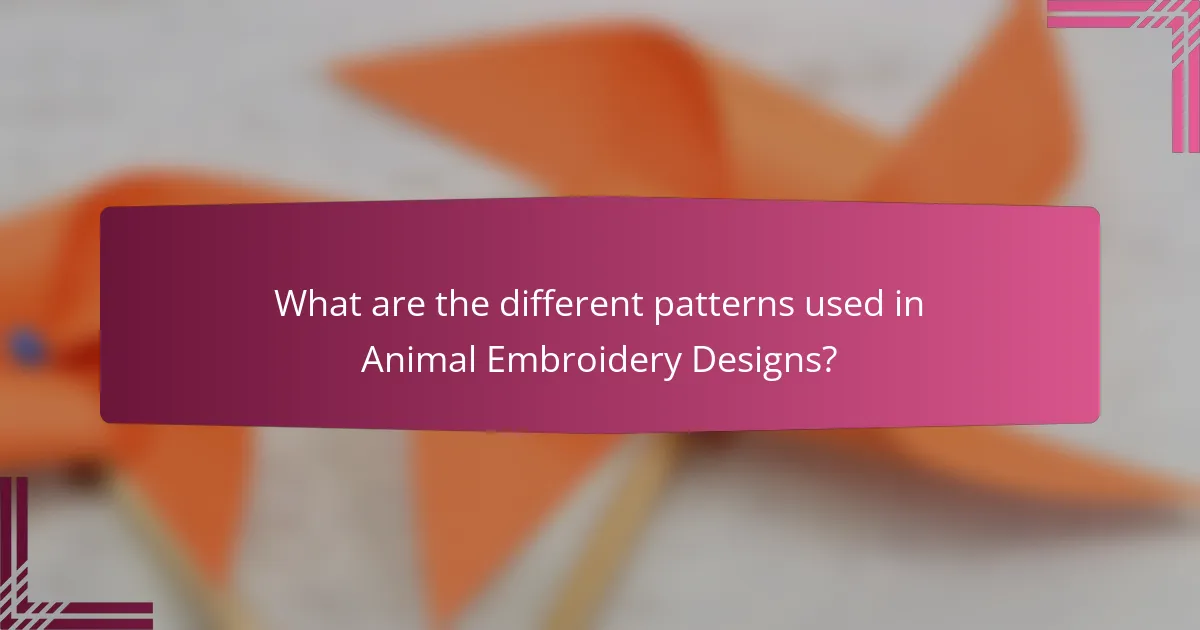
What are the different patterns used in Animal Embroidery Designs?
Animal embroidery designs utilize various patterns to depict animals. Common patterns include realistic imagery, stylized forms, and geometric shapes. Realistic imagery captures detailed representations of animals. Stylized forms simplify features for artistic effect. Geometric shapes create abstract interpretations of animals. Other patterns include silhouette designs and folk art styles. Silhouettes focus on the outline, while folk art incorporates cultural motifs. Each pattern serves different aesthetic purposes in embroidery.
How can patterns enhance the visual appeal of animal designs?
Patterns can enhance the visual appeal of animal designs by adding depth and interest. They create texture, making the design more engaging. Patterns can also establish a focal point, drawing attention to specific areas. Additionally, they can convey themes or emotions, enriching the overall narrative of the design. For example, floral patterns can evoke a sense of nature. Geometric patterns might suggest modernity and structure. Studies show that designs with intricate patterns are often perceived as more attractive. This perception can lead to increased viewer engagement and appreciation.
What are the most common types of patterns used in animal embroidery?
The most common types of patterns used in animal embroidery include realistic, stylized, and abstract designs. Realistic patterns depict animals in lifelike detail. Stylized patterns simplify animal forms into artistic representations. Abstract patterns use shapes and colors to suggest animals without direct representation. These patterns are popular due to their versatility in various embroidery styles. They can be found in traditional and contemporary works. The choice of pattern often reflects the artist’s intent and cultural influences.
How do geometric patterns differ from organic patterns in animal designs?
Geometric patterns in animal designs feature precise shapes and symmetrical arrangements. These patterns often include lines, circles, and angles. They create a structured and orderly appearance. In contrast, organic patterns are characterized by irregular shapes and flowing forms. These patterns mimic natural elements, such as leaves or animal fur. Organic designs tend to be more fluid and less predictable. The distinction lies in the use of symmetry versus asymmetry. Geometric patterns provide a sense of balance, while organic patterns evoke a sense of movement. This difference influences the overall aesthetic and emotional impact of the designs.
What role do motifs play in Animal Embroidery Designs?
Motifs play a crucial role in animal embroidery designs. They serve as the central visual elements that define the overall aesthetic. Motifs can represent specific animals, symbols, or themes. Their design influences the cultural significance of the embroidery. For instance, certain motifs may signify good luck or protection. The choice of motifs affects the emotional response of the viewer. Additionally, motifs contribute to the uniqueness of each embroidery piece. Historical context shows that motifs have evolved over time, reflecting changes in artistic trends and cultural values.
How can motifs be combined to create unique designs?
Motifs can be combined to create unique designs by layering, contrasting, and integrating different elements. Layering involves placing one motif over another to create depth. This technique can add complexity to the design. Contrasting motifs can enhance visual interest by juxtaposing shapes and colors. Integrating motifs requires thoughtful consideration of their themes and styles. For example, combining floral and animal motifs can create a harmonious yet dynamic composition. Historical practices in textile design show that such combinations often lead to innovative patterns. The use of color theory also plays a crucial role in ensuring that combined motifs complement each other.
What are some examples of popular motifs in animal embroidery?
Common motifs in animal embroidery include birds, butterflies, and mammals. Birds such as peacocks and owls are frequently depicted. Butterflies often represent transformation and beauty in designs. Mammals like foxes and elephants are popular for their symbolic meanings. These motifs are used in various cultures and styles, enhancing the visual appeal of the embroidery. Historical patterns often feature these animals, showcasing their significance in art and culture.
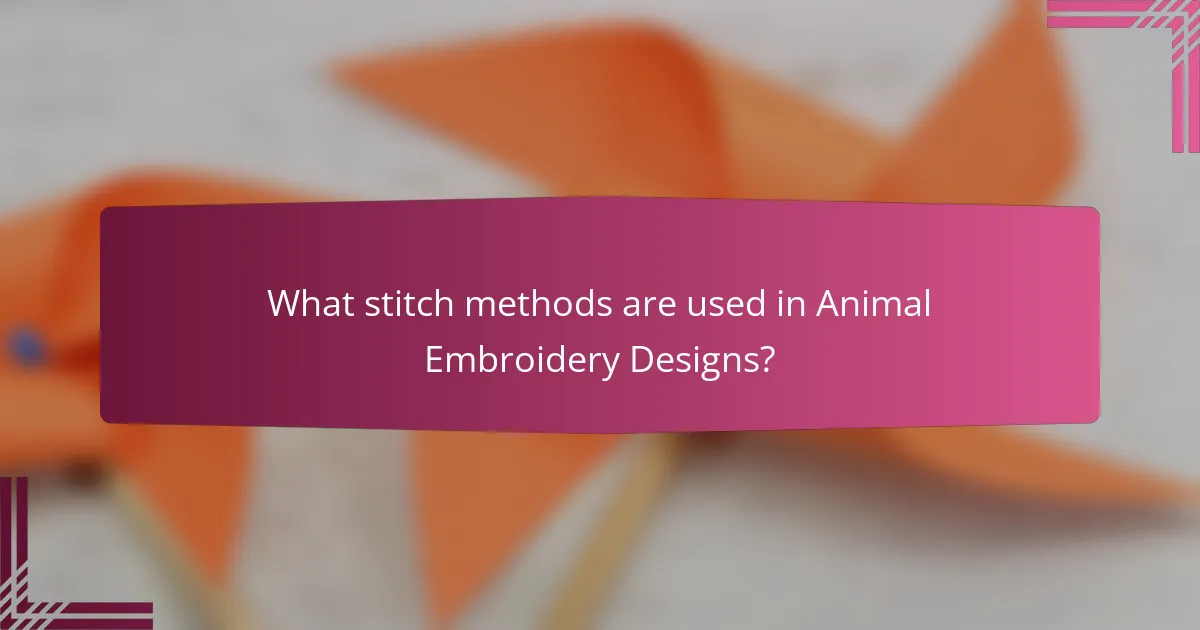
What stitch methods are used in Animal Embroidery Designs?
Animal embroidery designs utilize various stitch methods. Common methods include satin stitch, which creates a smooth, lustrous finish. Another method is the backstitch, known for its strong, defined lines. The French knot adds texture and dimension to the design. Chain stitch creates a decorative, linked appearance. Additionally, the running stitch is used for outlining and filling. Each method contributes to the overall aesthetic of the embroidery. These techniques are foundational in creating detailed and visually appealing animal designs.
How do different stitch techniques affect the final design?
Different stitch techniques significantly influence the final design in embroidery. Each technique alters the texture, appearance, and depth of the design. For example, satin stitch creates a smooth, shiny surface, enhancing color vibrancy. Conversely, backstitch provides defined outlines, adding structure to the design. Techniques like French knots introduce dimension, making elements appear more lifelike. Variations in stitch density can also impact the overall look. Tighter stitches yield a more compact design, while looser stitches create an airy effect. Ultimately, the choice of stitch technique directly shapes the visual and tactile qualities of the embroidery.
What are the most commonly used stitches in animal embroidery?
The most commonly used stitches in animal embroidery include satin stitch, backstitch, and French knot. Satin stitch is often used for filling in shapes, providing a smooth surface. Backstitch is popular for outlining and adding detail to animal features. French knots are frequently used to create textured effects, such as fur or eyes. These stitches are favored for their versatility and ability to enhance the visual appeal of animal designs.
How can stitch methods be combined for creative effects?
Stitch methods can be combined to create unique textures and visual effects in embroidery. For instance, blending satin stitch with backstitch can add depth to an animal’s fur. Combining French knots with chain stitch can create interesting patterns for eyes or flowers. Layering different stitches, like using a fill stitch beneath a decorative stitch, enhances dimensionality. Using contrasting thread colors in different stitch methods can also produce striking results. These combinations allow for greater creativity and personal expression in embroidery projects.
What are the best practices for mastering stitch techniques?
To master stitch techniques, practice consistently and focus on precision. Begin with basic stitches before progressing to complex ones. Use high-quality materials for better results. Maintain a steady hand while stitching to ensure even tension. Refer to instructional videos for visual guidance on techniques. Experiment with different patterns to enhance creativity. Join embroidery communities for feedback and support. Document your progress to identify areas for improvement.
How can beginners learn different stitch methods effectively?
Beginners can learn different stitch methods effectively by practicing with clear instructional resources. Online tutorials and videos provide step-by-step guidance on various stitch techniques. Books specifically focused on embroidery often include illustrations and patterns for beginners. Joining embroidery classes or workshops offers hands-on experience with expert guidance. Practice consistently to build muscle memory and confidence in each stitch method. Engaging with online embroidery communities can provide support and feedback. Utilizing practice fabric allows beginners to experiment without pressure. Tracking progress through a stitch journal can enhance learning and retention.
What resources are available for improving stitching skills?
Resources available for improving stitching skills include online tutorials, instructional books, and sewing classes. Online platforms like YouTube offer countless video tutorials covering various techniques. Websites such as Craftsy provide structured courses for different skill levels. Books like “The Complete Guide to Machine Embroidery” serve as comprehensive references. Local community centers often host sewing workshops and classes. Joining online forums or social media groups can provide peer support and tips. Additionally, practice kits with guided projects help reinforce skills. Accessing these resources can significantly enhance one’s stitching abilities.
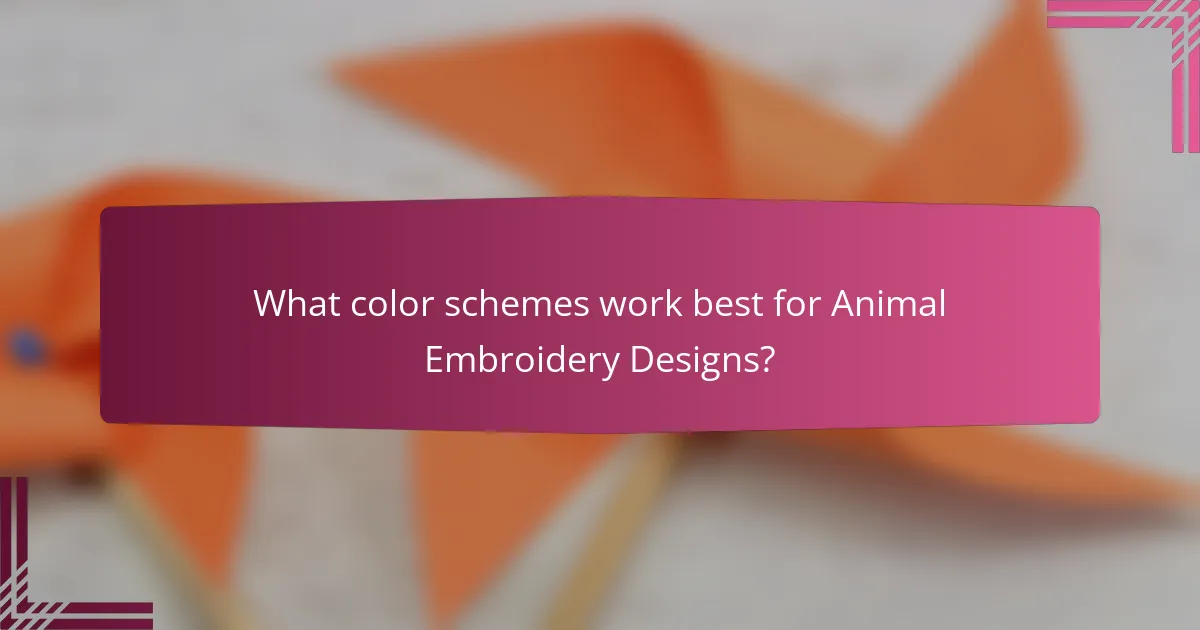
What color schemes work best for Animal Embroidery Designs?
Bright and contrasting color schemes work best for animal embroidery designs. These colors enhance visibility and detail in the design. Common combinations include vibrant shades of blue and orange, or green and pink. Earthy tones can also be effective, particularly for designs featuring wildlife. Using a limited palette of three to five colors can create a cohesive look. Additionally, gradients can add depth and dimension to the design. High-quality threads can improve color vibrancy and durability. Studies show that contrasting colors help in capturing attention and making designs stand out.
How do color choices impact the perception of animal designs?
Color choices significantly impact the perception of animal designs. Different colors evoke various emotions and associations. For instance, warm colors like red and orange can create feelings of excitement or aggression. Cool colors such as blue and green often convey calmness and tranquility.
The contrast between colors can enhance visibility and attention. High contrast designs tend to attract more focus from viewers. Additionally, cultural associations with colors can influence interpretation. For example, white may symbolize purity in some cultures, while in others, it may signify mourning.
Research indicates that color can affect memory and recognition. A study by Satyendra Singh in the “Journal of Marketing” found that color increases brand recognition by up to 80%. This principle applies to animal designs as well. Therefore, thoughtful color choices can enhance the effectiveness and appeal of animal designs in embroidery.
What are the principles of color theory applied to embroidery?
The principles of color theory applied to embroidery include color harmony, contrast, and the emotional impact of colors. Color harmony involves selecting colors that complement each other, creating a cohesive design. Contrast enhances visibility and interest by using opposing colors. The emotional impact of colors influences the viewer’s perception; for example, blue can evoke calmness while red can signify passion. Understanding these principles helps embroiderers make informed choices in their designs. Historical practices in art and design have shown that effective color application leads to visually appealing outcomes.
How can color palettes be created for animal embroidery projects?
Color palettes for animal embroidery projects can be created by selecting colors that represent the animal’s natural appearance. Start by observing the animal’s fur, feathers, or scales to identify dominant colors. Use a color wheel to find complementary and contrasting colors that enhance the design. Consider the mood or theme of the project; warm colors can evoke energy, while cool colors can create calmness. Test the selected colors on a sample fabric to see how they blend and contrast. It is beneficial to use software or apps that help visualize color combinations effectively. Many embroidery threads come with color swatches, which can aid in matching colors accurately.
What are some tips for selecting colors for animal embroidery?
Select colors for animal embroidery by considering the animal’s natural hues. Use a color wheel to find complementary colors. Choose shades that enhance the animal’s features. Consider the background fabric color to ensure contrast. Test thread colors against the fabric before finalizing. Use multiple shades for depth and dimension. Look at reference images for accurate color selection. Experiment with different color combinations for unique results.
How can contrasting colors enhance the design’s visibility?
Contrasting colors enhance a design’s visibility by creating a clear distinction between elements. This distinction helps viewers quickly identify important features. High contrast increases readability in text and graphics. For example, black text on a white background is easier to read than gray text. Studies show that designs with contrasting colors attract more attention. The use of complementary colors can highlight specific design aspects effectively. This principle is widely used in marketing and branding to capture interest. Overall, contrasting colors are essential for effective visual communication.
What are common color combinations that work well in animal embroidery?
Common color combinations that work well in animal embroidery include brown and beige, which mimic natural fur tones. Black and white create a striking contrast, ideal for animals like pandas or zebras. Blue and green can represent aquatic animals, evoking a sense of water. Bright colors like red and yellow are effective for birds, enhancing their vibrant appearance. Earthy tones like olive and rust work well for woodland creatures, providing a natural look. These combinations enhance the visual appeal and realism of the designs.
Animal embroidery designs are decorative patterns that prominently feature animals, utilizing various stitching techniques such as satin stitch, backstitch, and cross-stitch. This article covers the distinct characteristics of animal embroidery, including its historical significance, popular motifs, and the impact of cultural influences on design choices. It explores various patterns and stitch methods used to create these designs, as well as the importance of color schemes in enhancing their visual appeal. Additionally, the article discusses tips for selecting colors and combining motifs to achieve unique and meaningful embroidery projects.
